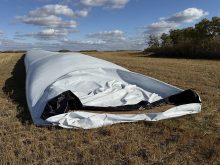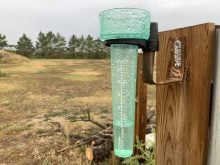Anyone harvesting, drying or handling mouldy grain should use respiratory protection, according to Ken Hellevang, agricultural engineer with the North Dakota State University Extension Service.
Mould can be a problem this spring in grain that was mouldy in the field or became infested with storage moulds. For instance, last year’s poor growing conditions meant some grain contained higher-than-normal moisture levels when placed in storage. With warm spring temperatures, conditions are conducive for mould growth.
Dust also may be a problem. Damaged grain will develop more fines as it is handled. Fines increase exposure to dust when handling grain or working in the bins.
Read Also

Milk transportation requires intricate logistics
Alberta Milk explains transportation system in Western Canada which sees millions of litres cross borders
The body has natural defense mechanisms, such as coughing and sneezing, that help prevent dust and other particles from entering the lungs.
“However, the mechanisms are not adequate to provide protection in a dusty environment, and the microscopic spores that moulds produce often can bypass these defenses because of their small size and overwhelming numbers,” Hellevang says.
Even low-level exposure to dust and mould can cause symptoms such as wheezing, a sore throat, nasal or eye irrigation, and congestion. Higher concentrations can cause allergic reactions and trigger asthma episodes and other problems.
Allergic reactions generally are the most common health problem of mould exposure, Hellevang says. Typical symptoms include wheezing and difficulty breathing; nasal and sinus congestion; burning eyes; watery, reddened, blurry vision; light sensitivity; dry, hacking cough; sore throat; nose and throat irritation; shortness of breath; and skin irritation. People may experience one or a combination of these symptoms.
In rare cases, severe symptoms, such as headaches, aches and pains and/or fever, may develop. People’s sensitivity varies based on the amount and type of mould.
In addition, certain types of moulds can produce mycotoxins, which are toxins the mould uses to inhibit or prevent the growth of other organisms. These mycotoxins increase the potential for health hazards from exposure to mould spores.
The type of respiratory protection people need will depend on the amount of their exposure to dust and mould. Hellevang recommends the minimum protection should be an N-95-rated face mask. This mask has two straps to hold it firmly to the face and a metal strip over the nose to create a tight seal.
Some masks also have a valve that makes breathing easier for people who wear them for extended periods.
A nuisance-dust mask with a single strap will not provide the needed protection because the mould spores will pass through the mask, Hellevang says.














